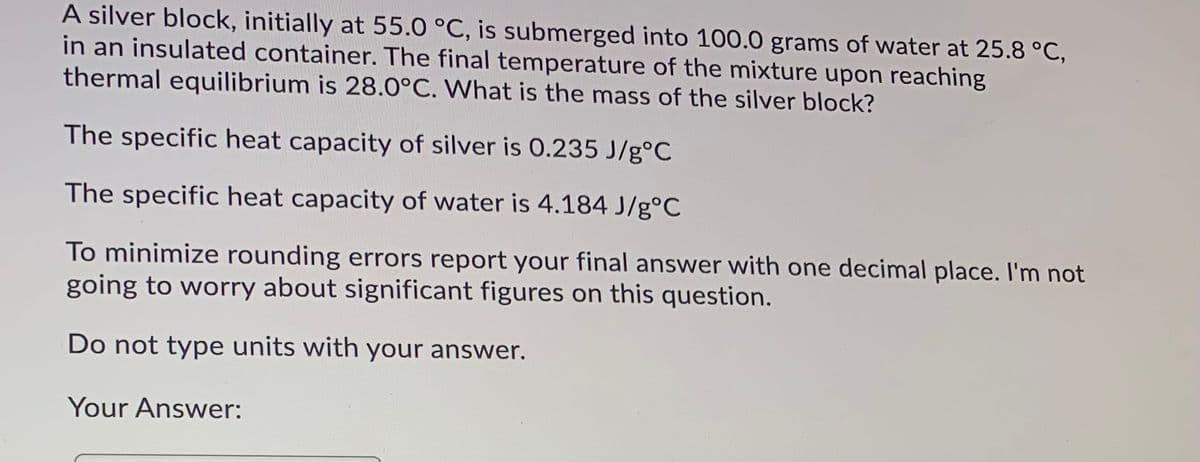A silver block, initially at 55.0 °C, is submerged into 100.0 grams of water at 25.8 °C, in an insulated container. The final temperature of the mixture upon reaching thermal equilibrium is 28.0°C. What is the mass of the silver block? The specific heat capacity of silver is 0.235 J/g°C The specific heat capacity of water is 4.184 J/g°C To minimize rounding errors report your final answer with one decimal place. I'm not going to worry about significant figures on this question. Do not type units with your answer. Your Answer:
A silver block, initially at 55.0 °C, is submerged into 100.0 grams of water at 25.8 °C, in an insulated container. The final temperature of the mixture upon reaching thermal equilibrium is 28.0°C. What is the mass of the silver block? The specific heat capacity of silver is 0.235 J/g°C The specific heat capacity of water is 4.184 J/g°C To minimize rounding errors report your final answer with one decimal place. I'm not going to worry about significant figures on this question. Do not type units with your answer. Your Answer:
Chemistry: The Molecular Science
5th Edition
ISBN:9781285199047
Author:John W. Moore, Conrad L. Stanitski
Publisher:John W. Moore, Conrad L. Stanitski
Chapter4: Energy And Chemical Reactions
Section: Chapter Questions
Problem 66QRT
Related questions
Question
100%

Transcribed Image Text:A silver block, initially at 55.0 °C, is submerged into 100.0 grams of water at 25.8 °C,
in an insulated container. The final temperature of the mixture upon reaching
thermal equilibrium is 28.0°C. What is the mass of the silver block?
The specific heat capacity of silver is 0.235 J/g°C
The specific heat capacity of water is 4.184 J/g°C
To minimize rounding errors report your final answer with one decimal place. I'm not
going to worry about significant figures on this question.
Do not type units with your answer.
Your Answer:
Expert Solution
This question has been solved!
Explore an expertly crafted, step-by-step solution for a thorough understanding of key concepts.
This is a popular solution!
Trending now
This is a popular solution!
Step by step
Solved in 2 steps

Knowledge Booster
Learn more about
Need a deep-dive on the concept behind this application? Look no further. Learn more about this topic, chemistry and related others by exploring similar questions and additional content below.Recommended textbooks for you

Chemistry: The Molecular Science
Chemistry
ISBN:
9781285199047
Author:
John W. Moore, Conrad L. Stanitski
Publisher:
Cengage Learning

Principles of Modern Chemistry
Chemistry
ISBN:
9781305079113
Author:
David W. Oxtoby, H. Pat Gillis, Laurie J. Butler
Publisher:
Cengage Learning

Chemistry: An Atoms First Approach
Chemistry
ISBN:
9781305079243
Author:
Steven S. Zumdahl, Susan A. Zumdahl
Publisher:
Cengage Learning

Chemistry: The Molecular Science
Chemistry
ISBN:
9781285199047
Author:
John W. Moore, Conrad L. Stanitski
Publisher:
Cengage Learning

Principles of Modern Chemistry
Chemistry
ISBN:
9781305079113
Author:
David W. Oxtoby, H. Pat Gillis, Laurie J. Butler
Publisher:
Cengage Learning

Chemistry: An Atoms First Approach
Chemistry
ISBN:
9781305079243
Author:
Steven S. Zumdahl, Susan A. Zumdahl
Publisher:
Cengage Learning

Chemistry
Chemistry
ISBN:
9781305957404
Author:
Steven S. Zumdahl, Susan A. Zumdahl, Donald J. DeCoste
Publisher:
Cengage Learning

Chemistry for Engineering Students
Chemistry
ISBN:
9781337398909
Author:
Lawrence S. Brown, Tom Holme
Publisher:
Cengage Learning
